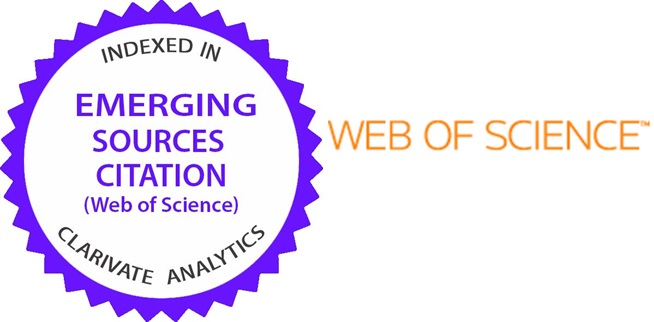Submissions
Submission Preparation Checklist
As part of the submission process, authors are required to check off their submission's compliance with all of the following items, and submissions may be returned to authors that do not adhere to these guidelines.- The submission has not been previously published, nor is it before another journal for consideration (or an explanation has been provided in Comments to the Editor).
- The submission file is in Microsoft Word document file format.
- Where available, URLs for the references have been provided.
- The text is single-spaced; uses Times New Roman and 11-point font; employs italics, rather than underlining (except with URL addresses); and all illustrations, figures, and tables are placed within the text at the appropriate points, rather than at the end.
- The text adheres to the stylistic and bibliographic requirements outlined in the Author Guidelines, which is found in About the Journal.
- If submitting to a peer-reviewed section of the journal, the instructions in Ensuring a Blind Review have been followed.
- The word limit of the manuscripts is strictly not more than 6,500 words (including references, all text in tables, figures and appendices).
Author Guidelines
PAPER TITLE SHOULD BE IN BOLD AND CAPS: CENTERED (FONT SIZE 12)
An Authora and Another Authorb (Full Name) centered (font size 11)
aDepartment, University, Full Address, City, Country. (Email: state the address)
bDepartment, University, Full Address, City, Country. (Email: state the address)
(justified, font size 11)
ABSTRACT
(heading is in caps, centered, font size 11)
The Abstract should be 150-250 words and contain the following 5 elements: Purpose of study; Design/methodology/approach; Findings; Research limitations and/or implications; Originality/value. (Text in font size 10, justified) Please note: There should be only one space after a period, colon, or semi-colon, and there should be no space before each of them (except for URL addresses for online references).
JEL Classification: code, another code, another code (refer to: http://www.aeaweb.org/journal/jel_class_system.php for the classifications) (justified; font size 10)
Keywords: Word, Another word, Another word (Five keywords separated by commas. Initial cap only; justified; font size 10)
1. ALL HEADINGS MUST BE IN CAPS (CENTERED; FONT SIZE 11; 2 SPACES AFTER 1.)
Text runs on the next line (font size 11). All justified; numbers to be included if supplied; no indent below. All paragraphs are indented (0.5 points) except for the first paragraph of each section. This first paragraph, for instance, is not indented.
This second paragraph, however, is indented at 0.5 points. All subsequent paragraphs in the same section will be indented in the same way. Please note again: There should be only one space after a period, colon, or semi-colon, and there should be no space before each of them (except for headings, sub-headings, and URL addresses for online references).
1.1 ALL SUB-HEADINGS MUST BE IN CAPS (CENTERED; FONT SIZE 10; 2 SPACES AFTER 1.1)
The same rule applies to a sub-section: Text runs on the next line (font size 11). All justified; numbers to be included if supplied; no indent below. All paragraphs are indented (0.5 points) except for the first paragraph of each sub-section. This first paragraph, for instance, is not indented.
This second paragraph, however, is indented at 0.5 points. All subsequent paragraphs in the same sub-section will be indented in the same way. Please note again: There should be only one space after a period, colon, or semi-colon, and there should be no space before each of them (except for headings, sub-headings, and URL addresses for online references).
1.1.1 ALL FURTHER SUB-HEADINGS MUST BE IN CAPS (CENTERED; FONT SIZE 10; 2 SPACES AFTER 1.1.1)
The same rule applies to a further sub-section: Text runs on the next line (font size 11). All justified; numbers to be included if supplied; no indent below. All paragraphs are indented (0.5 points) except for the first paragraph of each sub-section. This first paragraph, for instance, is not indented.
This second paragraph, however, is indented at 0.5 points. All subsequent paragraphs in the same sub-section will be indented in the same way. Please note again: There should be only one space after a period, colon, or semi-colon, and there should be no space before each of them (except for headings, sub-headings, and URL addresses for online references).
2. TABLES
The text in the table should be in font size 10. Only horizontal borders (1/2 point lines) should be drawn to separate row headings or specific sections of the table.
Reference to the table in the text should only have an initial cap, for instance, Table 1 or (Table 1). The table heading itself should be in caps while the title of the table should be in title case in the next line, as in the following example:
TABLE 1 (centered; font size 11)
Title in Title Case (Centered Above Table, Font Size 11)
|
Independent Variable |
Fixed Effects Model Estimates |
t-statistic (p-value) |
Random Effects Model Estimates |
t-statistic (p-value) |
Constant |
- |
- |
155.149 |
1.7660 (0.077)* |
|
LPCGHGDPit |
16.3905 |
0.8973 (0.372) |
17.3837 |
0.9552 (0.339) |
|
LGHAPOPit |
-100.897 |
-1.6059 (0.112) |
-78.2752 |
-1.2979 (0.194) |
|
LPCECGDPjt |
1.5434 |
2.0989 (0.038)** |
1.4482 |
2.7391 (0.006)** |
|
LECOPOPjt |
21.7770 |
1.4298 (0.156) |
3.5227 |
3.8523 (0.000)** |
|
LDISTANCEij |
- |
- |
-1.9906 |
-2.8459 (0.004)** |
|
TRENDt |
5.5709 |
1.4529 (0.149) |
5.5474 |
1.4516 (0.147) |
|
PSHOCKt |
-0.0173 |
-0.0197 (0.984) |
-0.4313 |
-5.666 (0.571) |
|
FRENCHt |
- |
- |
6.0202 |
2.2091 (0.027)** |
|
PORTUGt |
- |
- |
1.4851 |
0.6008 (0.548) |
|
R2 |
0.6929 |
|
0.5759 |
|
|
Adjusted R2 |
0.6308 |
|
0.5392 |
|
Note: This is a note, font size 9. (ranged left under table)
3. FIGURES
Similar to tables, reference to the figure in the text should only have an initial cap, for instance, Figure 1 or (Figure 1). The Figure heading itself should be in caps while the title of the figure should be in title case in the next line, as in the following example:
FIGURE 1
Example of a Figure Title
4. ABBREVIATIONS AND ACRONYMS
Define abbreviations and acronyms the first time they are used in the text, even after they have been defined in the abstract. Do not use abbreviations in the title or heads unless they are unavoidable.
5. EQUATIONS
Equations should be typed using Microsoft Equation. Number equations consecutively. Equation numbers, within parentheses, are to position flush left, as in (1), using a right tab stop. Italicize Roman symbols for quantities and variables, but not Greek symbols. Use a long dash rather than a hyphen for a minus sign. Punctuate equations with commas or periods when they are part of a sentence.
Be sure that the symbols in your equation have been defined before or immediately following the equation. Use “(1)”, not “Eq. (1)” or “equation (1)”, except at the beginning of a sentence: “Equation (1) is . . .” Use a zero before decimal points: “0.25”, not “.25”.
6. TRANSLITERATIONS
The transliteration for Arabic words (if any) needs to follow the exact spelling of the words in Arabic and conform to the Arabic Transliteration Guide provided.
7. CITATION OF REFERENCES IN TEXT
The full citation should be provided in the References section at the end of the paper for every source/reference cited in the paper. The full citation should not be at the footnotes. Also delete references that are not actually cited in the paper.
Reference to materials should be in the ‘Author, date’ format in the text. Unless there are four authors or more, give all authors' names; do not use “et al.”. Papers that have not been published, even if they have been submitted for publication, should be cited as “unpublished”. Papers that have been accepted for publication should be cited as “in press”. For papers published in translation journals, please give the English citation first, followed by the original foreign-language citation.
8. OTHERS
Other formatting guides are as follows:
|
Spelling preferences |
US English spelling |
|
Punctuation |
Initials (e.g. US, NJ, BBC) do not have full points between them. For names of article authors and in references, no space between initials (J.P. Smith or Smith, J.P. depending on position in the sequence of authors). Please consult the IIUM JEM Reference Style for additional information |
|
Dashes |
Spaced en rules for parenthetical dashes Use en rule between spans of numbers (e.g. 20–40), including page numbers in references |
|
Numbers and units |
Numbers: 1, 10, 1000, 10,000 10% (except at start of sentence) Units: follow author |
|
Dates |
4 October 2005 in the twenty-first century in the 1970s |
|
Book reviews |
BOOK REVIEW (as section heading) Book title: all bold, by Author and Author /edited by Author, Cambridge, Harvard University Press, 2003, xliii + 584 pp., US$28.95 (paperback), ISBN 0-95-445440-6 Reviewer’s Name Affiliation (Email) References go before reviewer details. |
ACKNOWLEDGEMENT (A heading)
Goes before endnotes and references. The text is smaller (font size 10). Put sponsor acknowledgments in the unnumbered footnote on the first page.
ENDNOTES (A heading)
(centred, font size 11. All footnotes should be placed as Endnotes at the end of the text, before the References section.)
- This is a note.
- This is another note.
Text font size 10.
REFERENCES
(The referencing style of the paper should strictly follow the style adopted by the journal (based on the Chicago Manual of Style). Please refer to the IJEMA Reference Style. The list should be in alphabetical order. Please comply with the caps, sequence and punctuation marks in the examples.)
Daily, B.F., J.W. Bishop and R. Steiner. “The Mediating Role of EMS Teamwork as it Pertains to HR Factors and Perceived Environmental Performance.” Journal of Applied Business Research (JABR) 23, no. 1 (2007): 95-110.
Evanston Public Library Board of Trustees. “Evanston Public Library Strategic Plan, 2000–2010: A Decade of Outreach.” Evanston Public Library. http://www.epl.org/library/strategic-plan-00.html
Fernandez, M. “Arbitrating Labor-Management Disputes.” North American Labor Relations 12, no. 3 (1989): 28–31.
Kuran, T. “The Provision of Public Goods under Islamic Law: Origins, Impact, and Limitations of the Waqf System.” Law and Society Review no. 1 (2001): 841–98.
———. “The Absence of the Corporation in Islamic Law: Origins and Persistence.” The American Journal of Comparative Law 53, no. 4 (2005a): 785–834.
Maes, Johan, and Luc Sels. "Mapping the Road to Innovation: The Effects of Upper Echelon Human Capital and HRM on Innovation in Start-ups." RENT XVIII Conference Proceedings, 24-6. 2004.
Mill, John Stuart. Autobiography and Literary Essays. Edited by John M. Robinson and Jack Stillinger. Toronto: University of Toronto Press, 1980.
Singjai, K., L. Winata, and T. Kummer. “Green Initiatives and Their Competitive Advantage for the Hotel Industry in Developing Countries.” International Journal of Hospitality Management no. 75 (2018): 131–43.
Vogel, Frank E., and Samuel L. Hayes. Islamic Law and Finance: Religion, Risk and Return. The Hague: Kluwer Law, 1998.
APPENDIX 1 (A heading)
Title in Title Case centred (font size 11)
Goes after references.
Privacy Statement
The names and email addresses entered in this journal site will be used exclusively for the stated purposes of this journal and will not be made available for any other purpose or to any other party.




